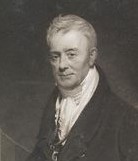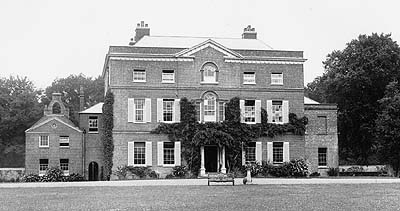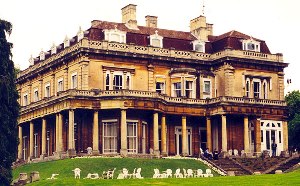| Charles Dundas | ||||
| Baron Amesbury
|
||||
| Son of: | Thomas Dundas of Fingask | |||
| and: | Lady Janet Maitland | |||
| born: | Thursday 5 August 1751 | |||
| education: | Edinburgh High School, Edinburgh University and Trinity College, Cambridge | |||
| occupation: | M.P 1775-1832. Counseller to Prince of Wales as great Steward of Scotland 1785-1820. Barrister | |||
| died: | 1832 in Pimlico | |||
Charles Dundas was created Baron Amesbury in 1832, and died the same year. He was called to the bar, but devoted himself to a political life. He first sat for the borough of Richmond in 1774, then for Orkney and Shetland (1781-4), again for Richmond and, finally, for Berkshire, which he represented in ten successive parliaments (1794-1832). He was, finally, the second eldest member in the house. Dundas was a liberal in politics. In 1802, on the resignation of Mitford (afterwards Lord Redesdale), the then speaker, he was nominated, by Sheridan, as his successor in opposition to Abbot. He, however, withdrew from the contest. Dundas was counsellor of state for Scotland to the Prince of Wales and colonel of the White Horse volunteer cavalry. |
||||
 |
||||
| 1st. | x 16/2/1782 Anne Whitley | |||
|
||||
| 1. | Janet Dundas | |||
| 2. | Marianne Dundas | |||
| 2ndly: | x 25/1/1822 Margaret Maitland (cousin) | |||
| It is often stated that Charles Dundas ony had one daughter, Janet, but this is incorrect | ||||
 |
||||
| Barton Court the home of Charles Dundas | ||||
Janet Dundas |
|
| Daughter of: | Charles Dundas |
| and: | Anne Whitley |
| born: | |
| died: | 1846 |
| x 1808 James Whitley Deans Dundas | |
| the following children were born of this union: | |
| 1. | Charles James Whitley Deans Dundas |
| 2. | James Whitley Deans Dundas |
| 3. | Ann Deans Dundas |
| 4. | Janet Deans Dundas died 1818 (Blackwoods Magazine) |
| 5. | Janet Deans Dundas |
| 6. | Sophia Deans Dundas |
|
|
||
| Daughter of: | Charles Dundas | |
| and: | Anne Whitley | |
| born: | ||
| died: | 4/12/1861 aged 68 at the home of her son in law, (James Morrell), Headington Hill House, Oxford | |
| x 1815 William Everett (died 1827) Rector at Romford Essex | ||
 |
||
| "The history of the Manor Queen Charlton, Somerset" | ||
 |
||
| The Scots Magazine , Volume 77, Part 1 | ||
| the following children were born of this union: | ||
| 1. | Charles Dundas Everett born 1817 Rector at Besselsleigh, Berks. Killed by a fall from his horse in 1881 in Wallingford, Berkshire | |
| 2. | William Everett born 1821 died Reading, Berks 23/11/1864. | |
| 3. | Alicia Harriet Everett born 1818 married 27/11/1851 James Morrell (d.1863) and died in 1864 leaving issue: | |
| a. | Emily Alicia Morrell born 4/1/1854 married George Herbert Morrell 4/2/1874 and died in 1938 leaving issue | |
| The 1861 census shows James Morrell (51) living at Headington Hill Hall with his wife Alicia Harriet (39) and their daughter Emily Alicia (7) and they had 18 servants (including a billiard marker and a page). But the couple only had about five years in their new mansion: James died in 1863, and Alicia in 1864. Their only child Emily Alicia Morrell (1854–1938) was left an orphan at the age of ten, so the Morrell Trustees took over responsibility for the Hall. The wealth of the child Emily was enormous: at the age of 19 she is listed in the Return of Owners of Land of 1873 as owning over 569 acres in Oxfordshire with an estimated rental income of £2,046. | ||
| In 1874, young Emily Alicia Morrell married her third cousin George Herbert Morrell (1845–1906) and returned with him to her family home. In the 1881 census, George Herbert Morrell (36) was at home in the Hall with his wife Emily (27) and their eleven servants. By 1891 they had two sons James (8) and George (6), plus thirteen servants: a butler, three footmen, three housemaids, two nurses, a kitchen maid, a scullery maid, a ladies maid, and a housekeeper. In 1901 the two sons were at Eton and there were now eleven servants (the nurses being no longer required). Mrs Emily Morrell died at the age of 84 in September 1938. A year later the government requisitioned the Hall for use as a military hospital, and its contents were sold. After the war the Hall became a rehabilitation centre run by the Red Cross and the Order of St John. | ||
| In 1953 Emily’s elder son, James Morrell III, sold Headington Hill Hall to Oxford City Council for a mere £13,700: this price included 37 acres of land, as well as its four lodges and outbuildings, and there was applause in the council chamber when the purchase was announced. The original plan was to demolish the Hall and build council offices on the site, but finances did not allow this, and so the council appropriated 20 acres to form Headington Hill Park and offered the rest of the estate on a 21-year lease to the highest bidder. This proved to be Robert Maxwell, Director of Pergamon Press, with a tender of £2,400 a year. Initially he rented the estate purely as business premises for the Press, but soon he and his wife Betty and eight children took up residence in the Hall, relegating the Press to the old stables. Maxwell restored the house, which had become dilapidated, ripping a 150-year-old chimney piece out of the old Pergamon offices in Fitzroy Square, London to put in his new home. He filled shelves with dummy books, and installed cinema-screen televisions in most of the rooms. The original Victorian stained-glass window on the stairs, showing Samson at the gates of Gaza, was damaged during the war, and was replaced by the Maxwells. The new window (left), created by an Israeli artist, casts Robert Maxwell himself as Samson. He has around his neck a large pendant, which is supposed to depict the head of Penelope and to indicate that behind every successful man there is a strong female presence. (This seems rather odd, in view of the damage Delilah did to Samson, and the fact that Penelope is a figure from Greek myth, not the Old Testament….) The grounds, meanwhile, were becoming littered with ugly prefabs to house Pergamon Press, and when Maxwell requested a longer lease in 1962, one of the conditions was attached was that he must erect,“within a period of 36 months from the granting of the lease, a new building of a type and design and on a site approved by the Council, to replace the existing five temporary huts, and within three months of the completion of this building, to demolish the five huts, clear their concrete bases, and reinstate the sites to their original condition”. In exchange for his original 21-year lease, he was granted 75 years’ tenure at an annual rent of £4,500, to remain fixed for the entire term (an incredible decision by the city council at a period of inflation). Maxwell did build a new office block, but the other promises he made (that he would make more of the Hall grounds available to the general public; that staff would have to use a new entrance at the back of the estate; and that no Pergamon cars would be allowed to use the main driveway, which would become a public footpath) were ignored. In 1978 Maxwell managed to extend his lease yet again, to 99 years, with the annual rent increased to £7,600 until 2002 (when there would be an annual increment until it reached £14,540 per year in 2076).With nearly a hundred years of security ahead of him, Maxwell turned the Headington Hill Hall site into a fortress. Guards were posted at the main entrance, the fence was reinforced with barbed wire, and video cameras were fixed to trees. Staff were kept away from the main house and its swimming pool and tennis court, although the old kitchen wing of the mansion was used as offices. Speakers were fitted to every office so that Maxwell could make announcements to the staff, who called the firm they worked for Purgatory Press. In March 1991 Maxwell sold Pergamon Press to Elsevier, and on 5 November that year Maxwell’s body was found in the sea. On 20 December Grant Thornton announced that they had been appointed receivers to 33 properties owned by PHL Estates Ltd (part of the Maxwell Group), including the 84 remaining years of the lease of Headington Hill Hall. In 1992 the Council negotiated a long lease with Oxford Brookes University. In 1996 the School of Art, Publishing and Music (Richard Hamilton building) was opened in the old stables and the Pergamon Press offices were converted into the Helena Kennedy Student Centre. Headington Hill Hall now forms the most glamorous part of Oxford Brookes University, and is the home of the School of Social Sciences and Law. It also has handsome function rooms, and is the only place in Headington licensed to hold civil wedding ceremonies. | ||
| http://www.headington.org.uk/history/listed_buildings/headhillhall.htm | ||
 |
||
| Headington Hill Hall | ||
| Charlotte Dundas |
|
| Daughter of: | Major General Thomas Dundas of Fingask |
| and: | Lady Eleanor Elizabeth Home |
| born: | Christened 6/4/1790 in Larbert, Stirling |
| died: | 1861. Buried Kensal Green Cemetery, London |
| x Sunday 11 July 1813 Hart Davis eldest son of Richard Hart Davis | |
| Charlotte Anna Dundas |
|
| Daughter of: | Thomas Dundas of Fingask |
| and: | Charlotte Anna Boultbee |
| born: | Tuesday January 6 1824 |
| died: | Thursday 4 June 1903 |
| 1st: | x Wednesday 12 February 1845 in Larbert, Stirling Colonel Armine Simcoe Henry Mountain |
| 2ndly: | x Saturday 12 May 1860 Sir John Henry Lefroy |
| Charlotte Anna Dundas |
|
| Daughter of: | Joseph Dundas of Fingask |
| and: | Margaret Isabella Moir |
| born: | Tuesday 30 August 1870 at Torquay |
| died: | Monday 28 August 1871 |
| |
|
| Daughter of: | Thomas Archibald Dundas |
| and: | Sybil Katherine Hampshire |
| born: | Sunday 16 October 1904 in British Columbia |
| x 1958 in Chichester, Sussex, Cecil G Allan | |
| Clementina Dundas |
|
| Daughter of: | Major General Thomas Dundas of Fingask |
| and: | Lady Eleanor Elizabeth Home |
| born: | born 8/5/1785, Christened 3/6/1785 at St. George, Bloomsbury, Middlesex |
| died | 13/6/1861 |
| x 1807 Thomas Bruce | |
|
|
| 1. | Thomas Bruce |
| 2. | David Bruce |
| 3. | John Bruce born March 1812 at Carron Hall died April 1913 |
| 4. | Charles Bruce born in Edinburgh December 1817 died at Groisons, near Tours, in 1833 and was buried at Tours. |
| 5. | Eleanor Dundas Bruce born 29/9/1809 at Montrose and died in Edinburgh 29/6/1829. Buried Episcopal Church of St. John the Evangelist. |
| 6. | Janet Anne Bruce born in Edinburgh 15th May 1814 died in 1830. |
| Clementina Dundas |
|
| Daughter of: | Thomas Dundas of Fingask |
| and: | Charlotte Anna Boultbee |
| born: | Thursday May 12 1825 |
| died: | Thursday 13 June 1867 |
| Brass tablet in Abbey Church, Kilculliheen, Waterford: In loving memory of their mother Clementina Bartolucci who died at Greenville Park in this parish 13 June 1867, these two windows are erected by her children, August 1883 | |
| Vincenzo Bartolucci x 1846 | |
| the following children were born of this union: | |
| 1. | Ida Dundas Bartolucci |
| 2. | Charlotte Dundas Bartolucci |
| 3. | Thomas Dundas Bartolucci |
| 4. | Candida Louisa Dundas Bartolucci |
| 5. | Evelyn Dundas Bartolucci |
| 6. | Louisa Dundas Bartolucci |
| 7. | Luigi Vincenzo Dundas Bartolucci |
| Eleanor Charlotte Dundas |
|
| Daughter of: | Joseph Dundas of Fingask |
| and: | Margaret Isabella Moir |
| born: | Saturday December 4 1858 in Farnham, Surrey |
| died: | 3rd June 1924 at Berwick |
| Eleanor Mary Dundas |
|
| Daughter of: | Ronald George Dundas |
| and: | Olive Mary Scott-Day |
| born: | Wednesday 24 June 1914 in British Columbia |
| x 17th Spet 1938 in Orange, California, Robert H Carney | |
| Eleanor Primrose Dundas |
|
| Daughter of: | Major General Thomas Dundas of Fingask |
| and: | Lady Eleanor Elizabeth Home |
| born: | Christened 20/2/1789 in Larbert, Stirling |
| died: | Tuesday 14 March 1815 in Harrogate |
| Anne Whitley Dundas |
|
| Daughter of: | Major General Thomas Dundas of Fingask |
| and: | Lady Eleanor Elizabeth Home |
| born: | 1793 in
|
| died: | July 1808 at Carron Hall, Perthshire |
